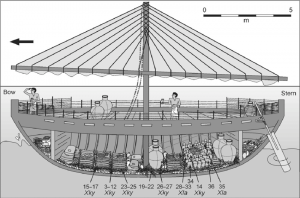Kas
Uluburun Shipwreck
The Uluburun Shipwreck is arguably one of the most important underwater discoveries of the 20th century. It was located in 1982 not very far from the town of Kas in southern Turkey. Eleven consecutive campaigns of three to four months duration took place from 1984 to 1994 totaling 22,413 dives, revealing one of the most spectacular Late Bronze Age assemblages to have emerged from the Mediterranean Sea(a). Because the wreck lay at a depth of 44-61 metres divers could only spend a very limited time  working on it, hence the large number of dives involved.
working on it, hence the large number of dives involved.
Radiocarbon dating techniques and the presence of identifiable pottery types place the date of the wreck as sometime in the late 14th century BCE, probably between 1330 and 1300 BCE.
>Peter James wrote a highly critical paper regarding the dendrochronological dating of the Uluburun shipwreck explaining “why the Uluburun date is dubious in the extreme and how its status as a ‘scientific’ date has gradually unravelled”(e).<
The main cargo of the ship was raw materials. The largest items were copper ingots, 348 of them, totalling 10 tons in weight. These took the form of ‘oxhide’ and circular buns, which refers to the shape they had, forms common in the Bronze Age Mediterranean(b). Isotope analysis revealed the ingots were pure copper and from Cyprus(c). Additionally, the cargo included a ton of tin ingots. These metals were estimated to be enough to make 5,000 bronze swords.
It did not take long before this discovery generated some wild speculation J.S. Wakefield & Reinoud DeJonge proposed that the Uluburun copper had come from the Michigan mines in their book Rocks & Rows, Sailing Routes across the Atlantic and the Copper Trade [760]. The late Gavin Menzies went further and proposed that not only was the Uluburun copper from Michigan but that it had been brought from America by the Minoans identified by him as Atlantean.
Now that exploration of the wreck has finished, scientists are engaged in a study of the amazing array of artefacts salvaged. Articles in 2022 and(d) 2023(f) revealed some of the unexpected discoveries made, including the source of the tin ingots.
(a) https://en.wikipedia.org/wiki/Uluburun_shipwreck
(b) https://www.worldhistory.org/Uluburun_Shipwreck/
(c) Isotope analysis reveals origins of Uluburun shipwreck cargo | The Past (the-past.com)
(e) https://www.centuries.co.uk/uluburun.pdf *
(f) https://www.re-thinkingthefuture.com/2023/02/18/a9360-lost-in-time-uluburun-shipwreck/ *
